Heterotroph - Study guides, Class notes & Summaries
Looking for the best study guides, study notes and summaries about Heterotroph? On this page you'll find 659 study documents about Heterotroph.
Page 4 out of 659 results
Sort by
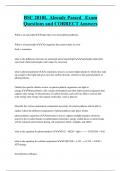
-
BSC 2010L Already Passed Exam Questions and CORRECT Answers
- Exam (elaborations) • 9 pages • 2024
-
- $7.99
- + learn more
What is an autoroph?make their own food (photosynthesis) What is a heterotroph?An organism that cannot make its own food; a consumer what is the difference between an autotroph and a heterotroph?autotrophs make their own food while heterotrophs can't make it's own food what is photorespiration?a respiratory process in many higher plants by which they take up oxygen in the light and give out some carbon dioxide, contrary to the general pattern of photosynthesis
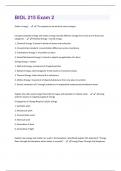
-
BIOL 215 Exam 2(Graded A+ actual test)
- Exam (elaborations) • 35 pages • 2024
- Available in package deal
-
- $7.99
- + learn more
Define 'energy'. - -The capacity to do work (to cause change) Compare potential energy and kinetic energy. Classify different energy forms into one of these two categories. - Potential Energy = stored energy 1. Chemical Energy: E stored in bonds of atoms and molecules 2. Concentration Gradient: concentration differences across membrane 3. Gravitational Energy: E of position or place 4. Stored Mechanical Energy: E stored in objects by application of a force Energy Energy = motion 1. Ele...
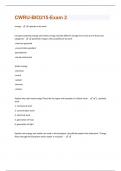
-
CWRU-BIO215-Exam 2 (Graded A+ actual test)
- Exam (elaborations) • 14 pages • 2024
- Available in package deal
-
- $7.99
- + learn more
energy - capacity to do work Compare potential energy and kinetic energy. Classify different energy forms into one of these two categories - potential energy is the possibility to do work: -chemical potential -concentration gradient -gravitational -stored mechanical kinetic energy -electrical -sound -radiant -thermal -motion Explain why cells need energy? Describe the types and examples of cellular work. - 1. synthetic work 2. mechanical work 3. concentration work 4. electrical ...

-
BIOS 242 Exam 2 Review Questions And 100% Correct Answers.
- Exam (elaborations) • 15 pages • 2024
-
Available in package deal
-
- $9.99
- + learn more
organic - Answer heterotrophs are? heterotroph - Answer •An organism that must obtain its carbon in organic form •Dependent on eating other life forms inorganic - Answer autotrophs are? autotroph - Answer •"Self-feeder" (photosynthesis or chemosynthesis) •Uses inorganic CO2 as its carbon source; builds organiccompounds from the CO2 phototroph - Answer an organism that gets its energy from sunlight chemotrophs - Answer Organisms that get energy from ch...
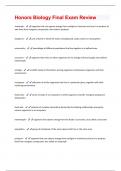
-
Honors Biology Final Exam Review Questions With 100% Correct Answers!!
- Exam (elaborations) • 22 pages • 2024
-
- $7.69
- + learn more
autotroph - organism that can capture energy from sunlight or chemicals and use it to produce its own food from inorganic compounds; also called a producer biosphere - part of Earth in which life exists including land, water, and air or atmosphere community - assemblage of different populations that live together in a defined area consumer - organism that relies on other organisms for its energy and food supply; also called a heterotroph ecology - scientific study of interactions among org...

-
Honors Biology Final Exam Review 2024 Questions and Answers 100% Pass
- Exam (elaborations) • 20 pages • 2024
- Available in package deal
-
- $12.49
- + learn more
Honors Biology Final Exam Review 2024 Questions and Answers 100% Pass autotroph - Answer- organism that can capture energy from sunlight or chemicals and use it to produce its own food from inorganic compounds; also called a producer biosphere - Answer- part of Earth in which life exists including land, water, and air or atmosphere community - Answer- assemblage of different populations that live together in a defined area consumer - Answer- organism that relies on other organisms for it...
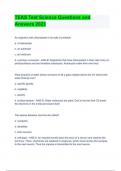
-
TEAS Test Science Questions and Answers 2023
- Exam (elaborations) • 40 pages • 2023
-
- $7.49
- + learn more
TEAS Test Science Questions and Answers 2023 An organism with chloroplasts in its cells is probably. a. a heterotroph b. an autotroph c. an herbivore d. a primary consumer - ANS-B: Organisms that have chloroplasts in their cells carry on photosynthesis and are therefore autotrophs. Autotrophs make their own food.
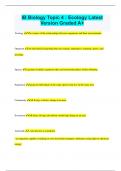
-
IB Biology Topic 4 : Ecology Latest Version Graded A+
- Exam (elaborations) • 11 pages • 2024
- Available in package deal
-
- $9.99
- + learn more
IB Biology Topic 4 : Ecology Latest Version Graded A+ Ecology The science of the relationships between organisms and their environments. Organism an individual living thing that uses energy, reproduces, responds, grows, and develops Species a group of similar organisms that can breed and produce fertile offspring Population group of individuals of the same species that live in the same area Community all living, or biotic, things in an area Ecosystem all biotic (living) and...

-
BIO 105 - Exam 2 Questions and Answers 100% Pass
- Exam (elaborations) • 15 pages • 2024
-
- $12.49
- + learn more
BIO 105 - Exam 2 Questions and Answers 100% Pass What is the relationship between energy incoming to the Earth from the sun and the size of a food web? A. Less incoming energy, more diverse food web B. No relationship C. More incoming energy, less diverse food web D. Greater energy, greater food web - Correct Answer ️️ -D. Greater energy, greater food web What is the most important thing that allows ecosystems to function? A. Atmosphere B. Water C. Soil D. Energy - Correct Answe...

-
BSC1011L Already Passed Exam Questions and CORRECT Answers
- Exam (elaborations) • 15 pages • 2024
-
- $8.49
- + learn more
Phylum Porifera (sponges) multicellular organisms without tissues, organs, or body cavity Heterotroph organism that obtains energy from the foods it consumes; also called a consumer Spicules hard spear or star-shaped structures; made of CaCO3 (limestone) or silica (glass) Choanocyte line the gastrovascular cavity & capture food Amoebocyte digest & distribute food Osculum large opening at the top where excess water leaves Spongocoel large central cavity of the sponge

That summary you just bought made someone very happy. Also get paid weekly? Sell your study resources on Stuvia! Discover all about earning on Stuvia


